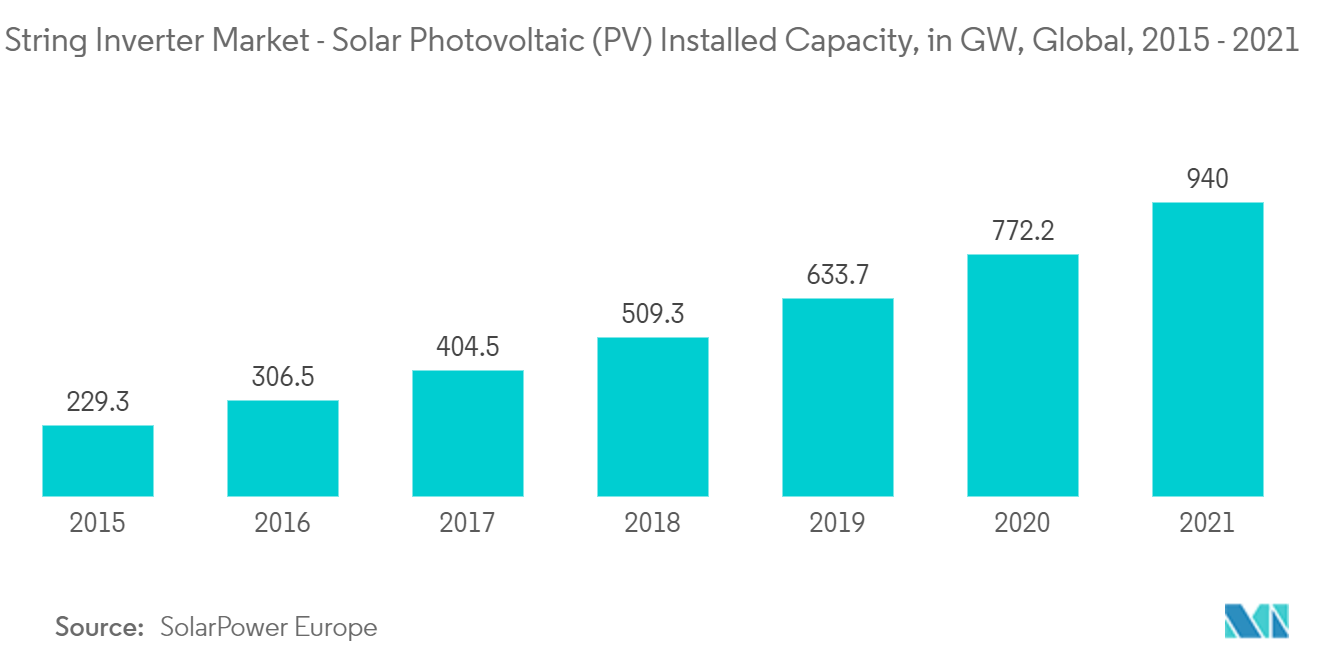Market Trends of String Inverter Industry
This section covers the major market trends shaping the String Inverter Market according to our research experts:
Utility Segment Likely to Witness Significant Growth
- Utility-Scale solar photovoltaic installations are massive projects covering multiple acres of land to generate electricity solely for distribution purposes. The string inverters convert the generated Direct Current (DC) by the solar panels into Alternating Current (AC).
- The utility-scale solar facilities generate electricity through several technologies that include Concentrating Photovoltaics (CPV), Concentrating Solar Power (CSP), and Photovoltaics (PV). Among all, photovoltaic is the most widely implemented technology on which string inverters are getting used.
- In 2021, global solar PV installed capacity was nearly 940 gigawatts (GW) and was expected to increase during the forecast period on account of various initiatives taken by the countries to have a sustainable and cheaper form of energy source.
- Utility segment string inverters are primarily three-phase, have a power rating of more than 80kW, and have unique properties to withstand extreme climatic conditions. With increasing demand, investment in solar utility projects has been growing over the years. Countries like China and the United States are among the top countries concentrating on having many utility projects in the upcoming years.
- Moreover, in September 2022, Yaskawa Solectria Solar, one of the few US-based manufacturers of solar inverters, formed a partnership with First Solar. Both companies are working to optimize the Solectria XGI 1500-250 utility-scale string inverters for First Solar's thin-film cadmium telluride solar modules. The partnership aims to create a version of the new XGI 1500-250 utility-scale string inverter that allows a grounded DC input.
- Such steps in the utility sector are likely to have a large installation of string inverters and thus help dominate the market during the forecast period.

Asia-Pacific to Witness Significant Growth
- Asia-Pacific is dominating the region with the highest installed capacity of solar PV and string inverters. In 2021, the region has nearly 484.930 gigawatts (GW) of solar PV installed capacity, with China, Japan, and India as the major countries.
- China is the major country in the region with approximately 306.56 GW of solar installations in 2021. It is expected that the country is planning to double its installation capacity by 2025, which is likely to expand the string inverter market during the forecast period.
- Also, Tengger Desert Solar Park, Longyangxia Dam Solar Park of China, Kurnool Ultra Mega Solar Park, and Kamuthi Solar Power Station of India are the few key projects in the region that have installed string inverters.
- Moreover, in July 2022, Kehua Data Co., Ltd. has announced that its SPI series 1500V/350kW string inverter passed the High Voltage Ride Through (HVRT) and Low (zero) Voltage Ride Through (LVRT) tests and obtained the certification report at one time.
- Furthermore, In June 2022, Ginlong (Solis) Technologies Co. Ltd announced an investment of CNY 2.925 billion, which is expected to be used for the production of string inverters and distributed photovoltaic power station projects. According to the announcement, the total investment of the new project with an annual output of 950,000 units of string inverters is estimated to be USD 0.160 billion.
- Owing to the above points and the recent developments, the Asia-Pacific region is expected to dominate the string inverter market during the forecast period.


